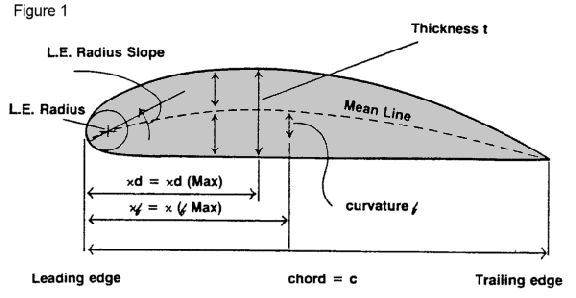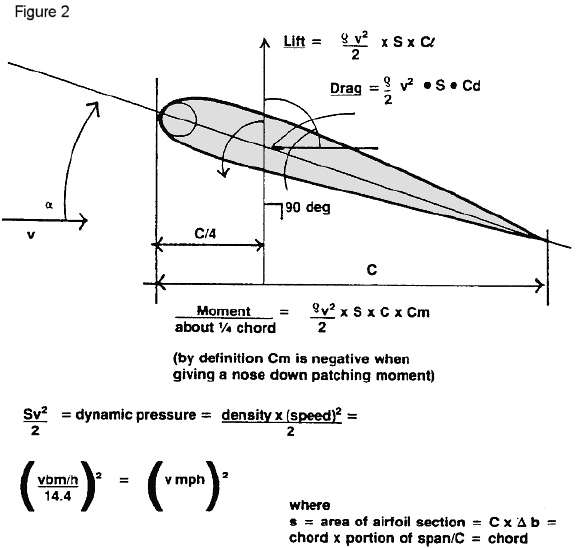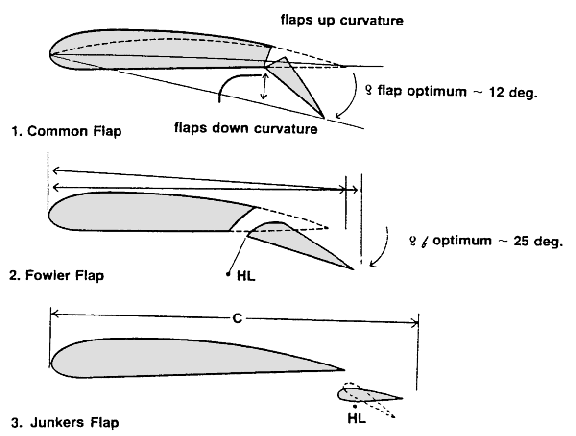Airfoils-Part 2
By Chris Heintz (originally published EAA Light Plane World, June 1987)
In part 1 of this series on airfoils we discussed the significance of relative motion, Reynolds numbers and the Boundary Layer (laminar or turbulent). And there was some homework on basic airfoil design and geometry so that the reader should now be familiar with chord, leading edge. trailing edge, mean line curvature, thickness etc., as shown in Figure 1.
As this discussion is limited to airfoils used on light planes, we will ask ourselves: What are the most significant features we would like to achieve with our airfoils?
- We want to fly as quickly as possible (short take-off), thus need high lift at low speed.
- We want to have full control of the aircraft as soon as airborne and throughout the whole speed range.
- For a given thrust (engine horsepower, intake, exhaust and propeller) we want a high cruise speed, thus need low drag at high speed.
- In all configurations we want a strong airframe without undue weight - thus we need a thick airfoil to be able to use a deep spar and have a large "torque tube" which will give bending strength and stiffness as well as torsional strength and rigidity.
- We also want good climb characteristics which means high lift and low drag in the climb attitude - with good engine cooling and a light airframe to be able to use full power and climb at slow speed with a high rate of climb (steep climb).
As already obvious from the above listing. there will be some compromising in the selection of the airfoil - but the airfoil is only one parameter. Others are wing planform (rectangular, tapered, etc.), wing tips, wing twist (we will discuss this topic, as it seems to be one that is frequently misunderstood or underestimated), wing aspect ratio, or span loading (which seems to be overestimated).
Over the years, it is very interesting to follow the designs of aircraft that are popular - there is a fashion in aircraft just as there is in clothing - pants, long skirts. mini skirts - racy looking aircraft, old fashion classics. new looks, etc.
The Force on an Airfoil
But let us look today at following basic airfoil requirements and later on see how we have to design the wing so that the same requirements can be further improved upon (or at least not lost!).
We'll consider:
- High Lift
- low drag
- Strong and stiff structure
With classic airfoils, those used over the last 30 to 50 years, we have accustomed to a maximum lift coefficient of 1.4 to 1.5 with a 12 to 15% thick (d/e) airfoil and a drag coefficient of .01 in cruise configuration (ie. NACA 4412, NACA 22012 and NACA 23012 or 23015). All of these airfoils are relatively insensitive to roughness (dirt or manufacturing imperfection) on the leading edge and except for the 4412 or 4415, their moment coefficient is relatively low so that the wing is not submitted to very large torsion at high speed (large Sv2/2 - see forces on an airfoil).
To increase the maximum lift, traditionally an appreciable increase in the camber is quite effective. Practically, this is done by deflecting the rear part the airfoil with so-called flaps (or ailerons, elevator or rudder).
It is also known that this substantial curvature increase is associated with a large Cm equivalent to .067 S flap (deg.) To avoid designing the whole aircraft for this condition the designer limits the "flap out" speed (VF) to a reasonable useful range.
Unless relatively complicated to build, when flaps (see next paragraph) are used, the increase in lift is moderate: to a CLMAX = 2.2, at Sf equivalent to 15 degrees. (This is a profile value - the whole wing which usually has only 1/2 span with flaps, has a CLMAX equivalent 1.9) and because the flaps are stalled on the upper surface (because the airstream has not enough momentum to overcome a sharp change of direction - due to an already thick boundary layer), the drag increase becomes quite substantial with Sf larger than 15 degrees and there is no improvement in the climb speed range.
This drawback of the "plain" flap is partially overcome with the more sophisticated "Fowler" flap, where a gap is created in such a way that, when deflected, air from underneath is caught in a "funnel," accelerated and "blown" into the boundary layer at the upper surface, thus allowing the airflow to follow the flap contour to deflections up to 25 degrees approximate.
Usually the Fowler flaps are not only deflected but also moved rearwards ( with a hinge point situated below the airfoil or a sophisticated track system as on the Cessna 152 and 172, etc.), which increases the wing area S by increasing the chord.
When homebuilders install this kind of flaps it is very important that they stick to the designer's geometry because the flap nose position with respect to the wing rear end is very critical to obtain maximum profile lift coefficient of up to 2.6 (see NACA Rep. No. 664 - 1939)
Split flaps, although quite effective, have fallen out of fashion and will not be discussed further [though I have re-introduced them with the ZENITH CH 2000].
A very interesting flap is the "Junker" type. It is a separate small airfoil under the wing trailing edge and hinged in such a way as to always create the "funnel effect" to reactivate the upper surface boundary-layer.
The Junker flap is especially interesting when used as ailerons (the ailerons are flap sections on the outboard wing panels, one being deflected down, the other up, so that the pilot has "roll control" over the aircraft.) As already mentioned the usual boundary layer is quite thick over the rear part of the airfoil and the ailerons need a certain minimum deflection to be effective. This is usually small "ineffective" roll control deflection from its neutral position. With the Junker type aileron, this is not the case if full advantage of the possible "funnel effect" is achieved by careful design ofthe hinge point location and careful construction.
- The drawback of this flap is that at high speed the funnel is always consuming some energy so that the drag coefficient is slightly higher than for a conventional flap.
But the 'Junker' flap is a very good compromise when excellent low speed in aileron controllability is desired, associated with high lift/low drag in climb configuration, and the top speed end is not so important. [That is why I chose the Junker flaperon for my STOL CH 701 design].
The 'Junker' flap always, and the 'Fowler' flap when extended, provide a certain 'boundary layer' control, be cause they 'trim" this layer out by blowing accelerated air into it, thus allowing the airflow to adhere to the solid airfoil up to substantial deflections (30 to 45 degrees) without local stalling of the airflow.
In our next article in this series, we will look at leading edge high lift devices.





